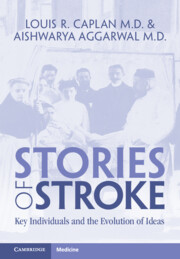Book contents
- Stories of Stroke
- Stories of Stroke
- Copyright page
- Contents
- Contributors
- Why This Book Needed to Be Written
- Preface
- Part I Early Recognition
- Part II Basic Knowledge, Sixteenth to Early Twentieth Centuries
- Part III Modern Era, Mid-Twentieth Century to the Present
- Types of Stroke
- Some Key Physicians
- Imaging
- Care
- Treatment
- Chapter Forty Three Clinical Stroke Trials
- Chapter Forty Four Heparin
- Chapter Forty Five Warfarin
- Chapter Forty Six Direct Oral Anticoagulants
- Chapter Forty Seven Aspirin
- Chapter Forty Eight Other Antiplatelets
- Chapter Forty Nine Other Medical Treatments
- Chapter Fifty Neuroprotection
- Chapter Fifty One Thrombolysis
- Chapter Fifty Two Treatment of Cerebral Venous Thrombosis
- Chapter Fifty three Recovery and Rehabilitation
- Chapter Fifty Four Carotid Artery Surgery
- Chapter Fifty Five Angioplasty and Stenting
- Chapter Fifty Six Endovascular Treatment of Acute Ischemic Stroke
- Chapter Fifty Seven Brain Aneurysm Treatment
- Chapter Fifty Eight Medical and Surgical Treatments of Intracerebral Hemorrhage
- Chapter Fifty Nine Treatment of Vascular Malformations
- Part IV Stroke Literature, Organizations, and Patients
- Index
- References
Chapter Forty Three - Clinical Stroke Trials
from Treatment
Published online by Cambridge University Press: 13 December 2022
- Stories of Stroke
- Stories of Stroke
- Copyright page
- Contents
- Contributors
- Why This Book Needed to Be Written
- Preface
- Part I Early Recognition
- Part II Basic Knowledge, Sixteenth to Early Twentieth Centuries
- Part III Modern Era, Mid-Twentieth Century to the Present
- Types of Stroke
- Some Key Physicians
- Imaging
- Care
- Treatment
- Chapter Forty Three Clinical Stroke Trials
- Chapter Forty Four Heparin
- Chapter Forty Five Warfarin
- Chapter Forty Six Direct Oral Anticoagulants
- Chapter Forty Seven Aspirin
- Chapter Forty Eight Other Antiplatelets
- Chapter Forty Nine Other Medical Treatments
- Chapter Fifty Neuroprotection
- Chapter Fifty One Thrombolysis
- Chapter Fifty Two Treatment of Cerebral Venous Thrombosis
- Chapter Fifty three Recovery and Rehabilitation
- Chapter Fifty Four Carotid Artery Surgery
- Chapter Fifty Five Angioplasty and Stenting
- Chapter Fifty Six Endovascular Treatment of Acute Ischemic Stroke
- Chapter Fifty Seven Brain Aneurysm Treatment
- Chapter Fifty Eight Medical and Surgical Treatments of Intracerebral Hemorrhage
- Chapter Fifty Nine Treatment of Vascular Malformations
- Part IV Stroke Literature, Organizations, and Patients
- Index
- References
Summary
Clinical trials have played a key role in the transformation of stroke from a neglected, untreatable condition to a field where some of the most dramatic outcomes are achieved. The development of concepts in stroke clinical trials has largely occurred during the last six decades and is closely linked to development of clinical trial methodology and evidence-based medicine in general. Stroke trials sometimes played a pioneering role in this development.
- Type
- Chapter
- Information
- Stories of StrokeKey Individuals and the Evolution of Ideas, pp. 413 - 426Publisher: Cambridge University PressPrint publication year: 2022

